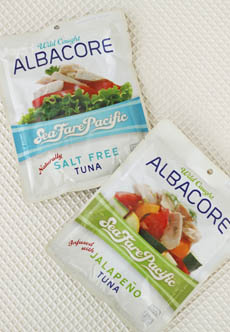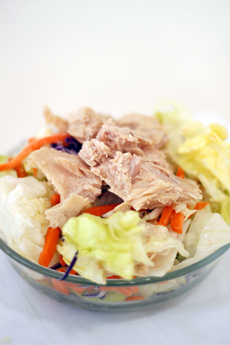PRODUCT: Sea Fare Pacific Tuna & Salmon Pounches
|
Recently one of our team embarked on a two-week trip to India. Problem: She doesn’t like Indian food.
We hooked her up with Sea Fare Pacific—sustainable, wild caught albacore tuna and salmon in lightweight, environmentally-friendly pouches. You don’t need to leave the country to enjoy the tuna and salmon, though. Sea Fare Pacific catches fish one at a time with a hook and line. The goal is to keep the earth and ecosystem safe, and to provide the highest-quality, omega-3 packed tuna with no mercury concerns. Unlike most supermarket brands, the fish is cooked only once to preserve its natural oils and flavors. The earth-friendly pouch keeps food fresher than a can, is lighter to tote and is more environmentally friendly. There’s no oil or water to drain—no messiness. Simply tear the seal and enjoy. The company was founded by Oregonian Mike Babcock, who aim to create a Pacific albacore tuna that tasted like his mother’s home-canned tuna. We haven’t tried Mom’s, but find Mike’s product to be excellent. |
 Lightweight, environmentally-friendly packaging. Photo by Elvira Kalviste | THE NIBBLE. |
|
 The tuna, in steak form, flaked for a salad. Photo by Elvira Kalviste | THE NIBBLE. |
Products The company points out that most brands of albacore tuna on the market are “twice cooked,” which causes the fish to lose most of its heart-healthy fats. Sea Fare Pacific products are cooked only once. |
|
|
Mercury In Tuna All tuna are not created equal, vis-a-vis mercury content. Albacore, often referred to as “chunk white” tuna, is one of the safest fish you can eat—provided it is caught in the U.S. Pacific or Canadian Pacific. The Seafood Watch project of the Monterey Bay Aquarium lists Albacore tuna caught in the US Pacific or Canadian Pacific as the “Best Choice.” These fish are younger and therefore have had less time to build up high levels of mercury. Most of the popular commercial brands use tuna imported from Southeast Asia, where the larger albacore tuna are much higher in mercury (and lower in omega 3s than their younger West Coast counterparts). “Chunk light” tuna is a blend of different species, and often includes meat from high-mercury bigeye tuna (along with less contaminated yellow fin). It’s best to avoid it. Do you know the different types of tuna?
|
||


